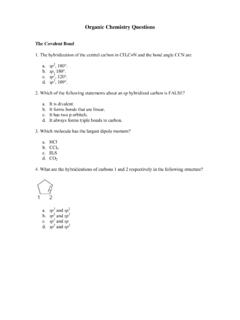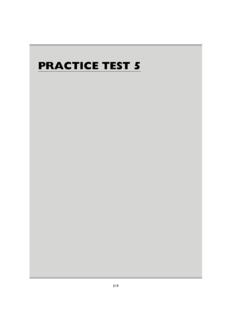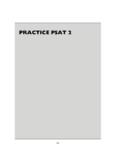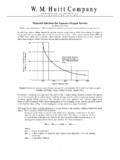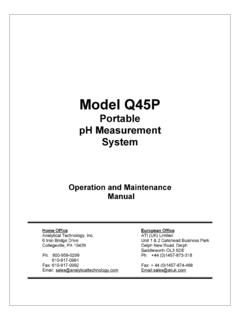Transcription of General Chemistry Questions - McGraw Hill Financial
1 General Chemistry Questions Electronic Structure and Periodic Table 1. What value or values of ml are allowable for an orbital with l = 2? a. 0 b. 2 c. -1 d. none of the above e. all of the above 2. According to Bohr Theory, which of the following transitions in the hydrogen atom will give rise to the least energetic photon? Use the equation: En = ( x 10-18 J)(1/n2) a. n = 5 to n = 3 b. n = 6 to n = 1 c. n = 4 to n = 3 d. n = 5 to n = 4 e. n = 6 to n = 5 3. Consider a 3dxz orbital. Which of the following statements is incorrect? a. The xz plane is a nodal surface. b. The xz plane divides the electron probability distribution into two identical mirror-image halves. c. The xy plane divides the electron probability distribution into two identical mirror-image halves. d. The yz plane divides the electron probability distribution into two identical mirror-image halves. e. The nucleus is located at a node.
2 4. The electronic configuration of the element whose atomic number is 26 is: a. 1s2 2s2 2p6 3s2 3p6 4s0 3d8 b. 1s2 2s2 2p6 3s2 3p6 3d6 4s2 c. 1s2 2s2 2p6 3s2 3p6 4s2 3d6 d. 1s2 2s2 2p6 3s2 3p6 4s2 3d4 4p2 e. none of the above 5. Which of the following has the largest radius? a. F b. N c. C d. O e. Ne 6. Which of the following elements has the largest ionization energy? a. Na b. Ne c. F d. K e. Rb 7. Which of the following has the greatest electron affinity (most negative value)? a. Cl b. K c. He d. Na e. Rb 8. Which of the following species is not isolectronic with any of the others? a. V3+ b. Ca2+ c. Ar d. Cl- e. S2- 9. In Bohr's model of the hydrogen atom, the radius of an orbit a. is proportional to n2. b. is smallest for the highest energy state. c. increases when a photon of light is emitted from an excited atom. d. can have any value that is larger than the ground-state radius.
3 E. none of the above 10. Which of the following atoms is not a one-electron system? a. H b. He+ c. Li2+ d. Be2+ e. O7+ 11. Which of the following statements about periodic properties is incorrect? a. Both electron affinity and ionization energy decrease down a group. b. Atomic size increases to the right across a period. c. Ionization energy increases to the right across a period. d. Atomic size increases down a group. e. Electron affinity increases to the right across a period. Bonding 1. Which one of the following is most likely to be an ionic compound? a. HNF2 b. H2CO c. N2H4 d. CaCl2 e. CH3Cl 2. In which of the following processes does the enthalpy change ( H) directly represent the magnitude of the lattice energy of KCl(s)? a. Cl2(g) + 2K(s) 2 KCl(s) b. KCl(s) K+(aq) + Cl-(aq) c. KCl(s) K+(g) + Cl-(g) d. KCl(s) K(s) + Cl-(g) e. KCl(s) K(s) + Cl(g) 3. Order the following by increasing bond strength: N N, N=N, N-N a.
4 N N, N=N, N-N b. N N, N-N, N=N c. N-N, N=N, N N d. N=N, N-N, N N e. N=N, N N, N-N 4. Which of the following compounds has the greatest bond polarity? a. PH3 b. NH3 c. HF d. H2S e. CH4 5. Which of the following is not planar? a. BCl3 b. ClF3 c. PCl3 d. XeF4 e. C2H4 6. Use VSEPR theory to predict the ideal bond angles around the two carbon atoms in acetaldehyde, CH3 CHO. (The first carbon has single bonds to three H atoms and one C atom; the second carbon has single bonds to C and H, and a double bond to O.) a. 109 , 109 b. 109 , 120 c. 120 , 109 d. 120 , 90 e. 105 , 105 7. In a carbon-carbon triple bond, what is the nature of the bonding between the carbons? a. two 2s orbitals overlapping b. two 2p orbitals overlapping c. two sp orbitals overlapping, two 2py overlapping and two 2pz overlapping d. an sp and sp2 overlapping and 2p orbitals overlapping e. an sp2 and sp2 overlapping and 2p orbitals overlapping 8.
5 Which of the following molecules has sp3 hybridization and a dipole moment? a. SiH4 b. BF3 c. NH3 d. BrF3 e. PCl5 9. In the molecular orbital description of bonding in benzene (C6H6), how many electrons occupy delocalized MOs? a. 2 b. 3 c. 4 d. 5 e. 6 10. In which of the following species is the octet rule violated by the central atom? a. CH4 b. SF4 c. PCl4+ d. SO2 e. NH3 11. The number of electron dots in the Lewis symbol for an element equals the a. number of outermost p electrons. b. number of electrons needed to fill the outermost p orbital. c. period number that contains the element. d. number of outermost s and p electrons. e. number of outermost s electrons. Phases and Phase Equilibria 1. Calculate the pressure of mol of NH3 gas in a L vessel at 25 C, using the ideal gas law. a. atm b. atm c. atm d. atm e. atm 2. A steel tank contains carbon dioxide at 34 C and is at a pressure of atm.
6 Determine the internal gas pressure when the tank and its contents are heated to 100 C. a. atm b. atm c. atm d. atm e. atm 3. Deviations from the ideal gas law are less at: a. high temperatures and high pressures b. high temperatures and low pressures c. low temperatures and high pressures d. low temperatures and low pressures e. high volumes and low temperatures 4. A mixture of three gases has a pressure of 1380 mmHg at at 298 K. The mixture is analyzed and is found to contain mol CO2, mol CO, and mol Ar. What is the partial pressure of Ar? a. 238 mm Hg b. 302 mm Hg c. 356 mm Hg d. 1753 mm Hg e. 8018 mm Hg 5. Which of the following exhibits the most hydrogen bonding? a. LiH b. CH4 c. NH3 d. H2S e. CH2F2 6. Which of the following carbon compounds has the highest melting point? a. CF4 b. CCl4 c. CBr4 d. CI4 e. CH4 7. Water has such a high specific heat because a.
7 It has such a low molecular weight. b. it is rather dense. c. the O-H single bond has a high bond energy. d. it has many relatively strong hydrogen bonds. e. it dissolves both ionic and covalent compounds. 8. The triple point is a. an end to the liquid-gas line in a phase diagram. b. the relationship between the boiling point, melting point and vapor pressure of a substance. c. the point on a phase diagram where solid, liquid, and gas are in equilibrium. d. the three pieces of data needed to solve the Clausius-Clapeyron equation. e. the (P,V,T) coordinate of a point on a phase diagram. 9. The main forces responsible for the structure of DNA are a. ionic bonds and covalent bonds. b. covalent bonds and ionic bonds. c. hydrogen bonds and dipole-dipole interactions. d. covalent bonds and hydrogen bonds. e. covalent bonds and dipole-dipole interactions. 10. Which of the following is not likely to exhibit hydrogen bonding?
8 A. CH3CH2OH b. CH3NH2 c. H2O d. NH2OH e. (CH3) 3N Stoichiometry 1. What is the mass of one mole of acetylsalicylic acid (aspirin), C9H8O4? a. 29 g b. 108 g c. 196 g d. 180. g e. none of the above 2. Determine the number of moles of aluminum in x 10-1 kg of Al. a. 5816 mol b. mol c. x 1023 mol d. mol e. mol 3. How many grams of zinc are there in g of ZnCl2? a. g b. g c. g d. 1476 g e. g 4. A compound with a composition of % N and % H was recently discovered. What is the empirical formula for this compound? a. NH2 b. N2H3 c. NH d. N2H2 e. N2H 5. This equation is unbalanced: PCl3 + H2O H3PO3 + HCl When it is correctly balanced, the coefficients are, respectively a. 1,3,1,1 b. 1,1,1,3 c. 1,3,1,3 d. 2,3,2,3 e. none of the above 6. Given 6 mol of each reactant, which one would be limiting in the following reaction? 4Au + 8 NaCN + O2 + 2H2O 4 NaAu(CN)2 + 4 NaOH a.
9 Au b. NaCN c. O2 d. H2O e. There is no limiting reactant. 7. In the direct reaction of silicon with Cl2 the yield of SiCl4 is 50. %. How many grams of silicon must be reacted with excess chlorine in order to obtain 17 g SiCl4? a. g b. g c. g d. 17 g e. 28 g 8. In the reaction of Fe3O4 with carbon to form carbon dioxide and iron, the number of moles of carbon required to convert 23 g of Fe3O4 to products is a. b. c. d. e. 9. A mL sample of an element with a density of g/mL contains 4 x 1023 atoms. What is the atomic weight of this element? a. 300 b. 40 c. 60 d. 90 e. none of the above 10. How many moles of oxygen gas will react with mol aluminum? Equation: 4Al + 3O2 2Al2O3 a. mol b. mol c. mol d. mol e. mol 11. Balance the following redox equation occurring in aqueous solution: KMnO4 + KCl + H2SO4 MnSO4 + K2SO4 + H2O + Cl2 What is the stoichiometric coefficient for chlorine (Cl2) when the equation is balanced with smallest whole number coefficients?
10 A. 1 b. 3 c. 5 d. 8 e. 10 Thermodynamics and Thermochemistry 1. Data: (1) H2(g) + O2(g) H2O(g) H = kJ (2) H2(g) + O2(g) H2O(l) H = kJ On the basis of the above data, which of the following statements is false? a. Reaction (1) is exothermic. b. Reaction (2) is the formation reaction for H2O(l). c. The reverse of reaction (2) is endothermic. d. The energy content of H2O(g) is lower than H2O(l). e. H for the reaction: H2O(l) H2O(g) is + 44 kJ/mol. 2. What is the amount of heat necessary to raise the temperature of kg of water from C to 84 C? a. x 103 kJ b. 36 J c. x 103 kJ d. x 106 kJ e. 25 kJ 3. Data: H f values: CH4(g), kJ; CO2(g), kJ; H2O(l), kJ. Using the H f data above, calculate H rxn for the reaction below. Reaction: CH4(g) + 2O2(g) CO2(g) + 2H2O(l) a. kJ b. kJ c. kJ d. kJ e. none of the above 4. Data: 2Ba(s) + O2(g) 2 BaO(s) H = kJ Ba(s) + CO2(g) + O2(g) BaCO3(s) H = kJ Given the data above, calculate H for the reaction below.
